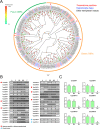Transcriptome sequencing of Tessaratoma papillosa antennae to identify and analyze expression patterns of putative olfaction genes
- PMID: 28596537
- PMCID: PMC5465196
- DOI: 10.1038/s41598-017-03306-7
Transcriptome sequencing of Tessaratoma papillosa antennae to identify and analyze expression patterns of putative olfaction genes
Abstract
Studies on insect olfaction have increased our understanding of insect's chemosensory system and chemical ecology, and have improved pest control strategies based on insect behavior. In this study, we assembled the antennal transcriptomes of the lychee giant stink bug, Tessaratoma papillosa, by using next generation sequencing to identify the major olfaction gene families in this species. In total, 59 odorant receptors, 14 ionotropic receptors (8 antennal IRs), and 33 odorant binding proteins (28 classic OBPs and 5 plus-C OBPs) were identified from the male and female antennal transcriptomes. Analyses of tissue expression profiles revealed that all 59 OR transcripts, 2 of the 8 antennal IRs, and 6 of the 33 OBPs were primarily expressed in the antennae, suggesting their putative role in olfaction. The sex-biased expression patterns of these antenna-predominant genes suggested that they may have important functions in the reproductive behavior of these insects. This is the first report that provides a comprehensive resource to future studies on olfaction in the lychee giant stink bug.
Conflict of interest statement
The authors declare that they have no competing interests.
Figures






Similar articles
-
Identification and expression profile of odorant-binding proteins in Halyomorpha halys (Hemiptera: Pentatomidae).Insect Mol Biol. 2016 Oct;25(5):580-94. doi: 10.1111/imb.12243. Epub 2016 May 12. Insect Mol Biol. 2016. PMID: 27170546
-
Candidate genes coding for odorant binding proteins and chemosensory proteins identified from dissected antennae and mouthparts of the southern green stink bug Nezara viridula.Comp Biochem Physiol Part D Genomics Proteomics. 2019 Sep;31:100594. doi: 10.1016/j.cbd.2019.100594. Epub 2019 May 11. Comp Biochem Physiol Part D Genomics Proteomics. 2019. PMID: 31170686
-
Antennal transcriptome analysis and comparison of olfactory genes in two sympatric defoliators, Dendrolimus houi and Dendrolimus kikuchii (Lepidoptera: Lasiocampidae).Insect Biochem Mol Biol. 2014 Sep;52:69-81. doi: 10.1016/j.ibmb.2014.06.006. Epub 2014 Jul 3. Insect Biochem Mol Biol. 2014. PMID: 24998398
-
Identification of Male- and Female-Specific Olfaction Genes in Antennae of the Oriental Fruit Fly (Bactrocera dorsalis).PLoS One. 2016 Feb 4;11(2):e0147783. doi: 10.1371/journal.pone.0147783. eCollection 2016. PLoS One. 2016. PMID: 26845547 Free PMC article.
-
Odorant-binding and chemosensory proteins identified in the antennal transcriptome of Adelphocoris suturalis Jakovlev.Comp Biochem Physiol Part D Genomics Proteomics. 2017 Dec;24:139-145. doi: 10.1016/j.cbd.2016.03.001. Epub 2016 Mar 9. Comp Biochem Physiol Part D Genomics Proteomics. 2017. PMID: 27085212
Cited by
-
Identification and expression analysis of putative chemoreception genes from Cyrtorhinus lividipennis (Hemiptera: Miridae) antennal transcriptome.Sci Rep. 2018 Aug 28;8(1):12981. doi: 10.1038/s41598-018-31294-9. Sci Rep. 2018. PMID: 30154418 Free PMC article.
-
Stink Bug Communication and Signal Detection in a Plant Environment.Insects. 2021 Nov 25;12(12):1058. doi: 10.3390/insects12121058. Insects. 2021. PMID: 34940147 Free PMC article. Review.
-
Analysis of Chemosensory Genes in Full and Hungry Adults of Arma chinensis (Pentatomidae) Through Antennal Transcriptome.Front Physiol. 2020 Nov 6;11:588291. doi: 10.3389/fphys.2020.588291. eCollection 2020. Front Physiol. 2020. PMID: 33240109 Free PMC article.
-
Identification of Candidate Olfactory Genes in the Antennal Transcriptome of the Stink Bug Halyomorpha halys.Front Physiol. 2020 Jul 24;11:876. doi: 10.3389/fphys.2020.00876. eCollection 2020. Front Physiol. 2020. PMID: 32792985 Free PMC article.
-
The whole body transcriptome of Coleophora obducta reveals important olfactory proteins.PeerJ. 2020 Apr 10;8:e8902. doi: 10.7717/peerj.8902. eCollection 2020. PeerJ. 2020. PMID: 32309046 Free PMC article.
References
-
- Steinbrecht RA. Pore structures in insect olfactory sensilla: A review of data and concepts. Int. J. Insect Morphol. 1997;26:229–245. doi: 10.1016/S0020-7322(97)00024-X. - DOI
Publication types
MeSH terms
Substances
LinkOut - more resources
Full Text Sources
Other Literature Sources

